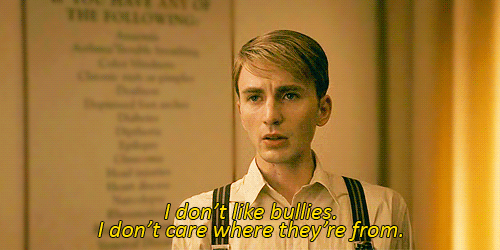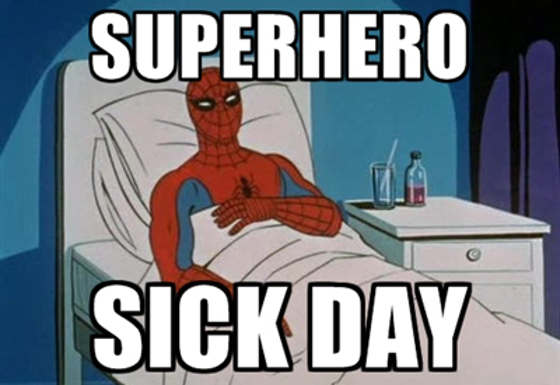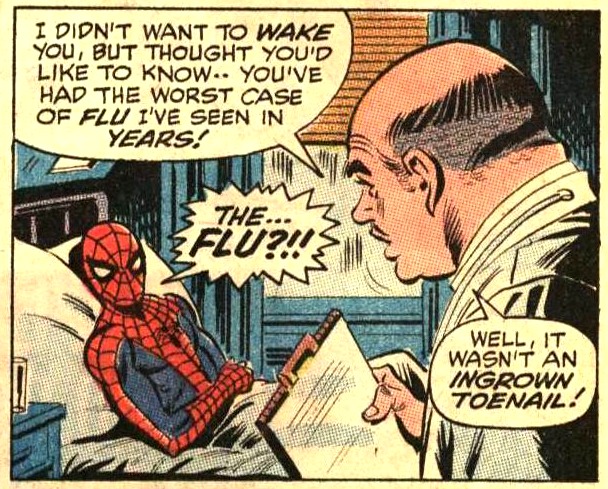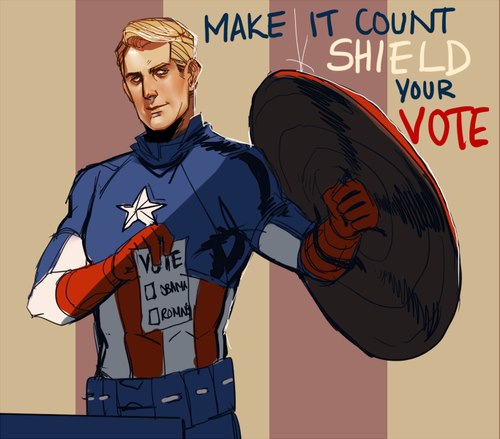Bullies in the Classroom

{Image is a gif of pre-serum Steve Rogers from Captain America: The First Avenger.}
“I don’t like bullies. I don’t care where they’re from.”
-Steve Rogers, Captain America: The First Avenger
Today’s blog post is not about superheroes. It’s about the absence of them–about the fact that, no matter how fiercely I love my kids, no matter how much I emphasize the values of patience and respect, they won’t always be super kids. Just like I won’t always be a super teacher. Children can be fantastically accepting. They can also be brutally judgmental.
About once a year, my students go through a fit of bullying. They pick on each other all year long, but once a year, they find a target and go after them. I remedy this with an anti-bullying curriculum, the introduction to which I will leave at the end of this post. This curriculum works well with the 2nd-8th grade set.
Younger children are more complicated. After school, I sometimes help watch the younger students. One of the three-year-olds, “Betsy,” was nonverbal when she joined us a little less than two months ago. Today, she came up to me with her coat and said, “Zip my jacket.” Her acquisition of language has been swift and astounding. Honestly? I love all my kids, but Betsy’s special. She comes to me when she’s feeling squealy, spinny, stimmy. We flap our arms together and laugh. I adore her kinetic joy. I’m constantly proud of her strong, high voice, even when she’s using it to yell “MOVE!” at the other kids. Hey, assertiveness is a positive trait.
The kindergarteners have been mocking her voice. They play with her with the express purpose of laughing at her. They mimic her and laugh, and Betsy laughs along. She doesn’t get why they’re laughing. She just thinks they’re having fun.
This infuriates me. Partially because Betsy is so special to me, yes. But partially because some of those kindergarteners are special to me, too. Two of them are the younger siblings of my favorite student (listen, you can have favorites without playing favorites; I think I’ve gotten pretty good at this over the years). They’re bright kids. Sassy, noisy, wild, smart kids. Kids who I love. That makes their bullying more difficult for me to handle.
I told them off for it today, all four of them, that posse of kindergartners laughing at a three-year-old who’s just found her voice. They stopped for a minute as we walked up the stairs from the cafeteria to the restrooms. Then, in the restroom, they started up again. Betsy loves to sing in the restroom: her sweet, garbled song. The girls mimicked her as they stood in line in the hall.
Betsy got to go out to recess with the boys. I kept the kindergarten girls back. How would you feel, I asked, if your friend was making fun of you? I told them off. I had them sit in time-out. I had them apologize.
They’ll do it again. Maybe not as often. But they’ll do it.
Sometimes this superhero teacher feels pretty useless.
Bullying Myths and Facts
Myth: Bullies will go away if you ignore them.
Fact: Bullies WON’T always go away if you ignore them. Sometimes, they’ll take you ignoring them as a sign that you’re okay with them bullying you. The only sure way to get bullies to stop bullying you is to tell an adult so the adult can help keep you safe.
Myth: All bullies have low self-esteem.
Fact: Some bullies do have low self-esteem, but that should not be used as an excuse for their actions. No matter whether a bully has low self-esteem or not, they don’t have the right to bully anyone.
Myth: People might be hurt when they get bullied, but they’ll get over it.
Fact: Not everybody gets over being bullied. Bullying can lead to anxiety—a long-lasting condition where your brain releases chemicals that make you feel scared, even when you’re not in a situation that would normally scare you—or depression—another long-lasting condition where your brain doesn’t release enough chemicals to make you happy, so you feel tired and sad. Some people never get over all the fear caused by bullies. That’s why bullying is so terrible. What happens to you as a kid can affect you for the rest of your life.
Myth: Bullying is just a normal part of growing up.
Fact: A lot of people are bullied while they’re growing up, but bullying shouldn’t be considered normal. Some people say it’s normal because they feel helpless to stop bullies.
Myth: The best way to get rid of a bully is to fight and get even.
Fact: Fighting and getting even doesn’t stop bullies. If you try to hurt your bully on purpose, then you’ve become a bully, too. The best way to stop a bully is to tell an adult you trust what’s going on.
Myth: Bullying is just teasing.
Fact: Some teasing is bullying, but bullying is never just teasing. It’s not the victim’s fault for being upset. It’s the bully’s fault for hurting the other person.
Myth: People who complain about bullies are babies.
Fact: People are not babies for telling on the people who bully them. They are very brave. It’s scary to tell on your bullies. Some bullies say they’ll hurt the people they’re bullying if they tell. It’s always best to tell and get help.
Myth: Telling on a bully is the same as tattling.
Fact: Telling on a bully is not tattling. If an adult doesn’t listen to you because they think you’re just tattling, and the bully keeps bothering you, tell another adult you trust what’s going on. Keep telling adults you trust about the bully until one of the adults helps you.
Myth: Only boys are bullies.
Fact: Both boys and girls can be bullies.
Myth: Some people deserve to be bullied.
Fact: NO ONE deserves to be bullied.
How has your classroom dealt with bullying? Let me know in the comments.


